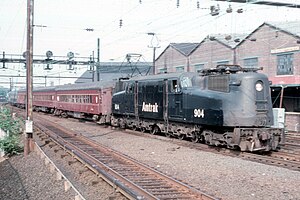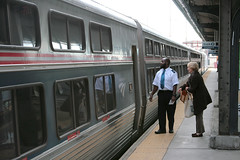 Image via Wikipedia
Image via WikipediaFrom the Editors…
Something is turning 40, and oddly enough someone wants you to know about it. This and other more somber milestones are covered this week.
Of Time and (Wall) Space
If you are not already aware, Amtrak intends to make very sure you will be: On May 1, the National Railroad Passenger Corporation (NRPC) -- yes, that is still Amtrak’s legal name -- will achieve 40 years of existence. According to its internal newsletter, Amtrak Ink, there are numerous outlets planned to observe this latest milestone. There will be a commemorative book for which Amtrak has already canvassed its employees for pictures. There will also be a video by “an Emmy award-winning producer.” Also, “Beech Grove is renovating surplus equipment and restoring one F-40, one P-40, three baggage cars, and an Amfleet food service car for a special 40th anniversary `museum train' that will travel across the country to many employee locations.” Since when has Amtrak had “surplus” equipment?
One thing is for certain, this year’s Amtrak wall calendar makes the pronouncement loud for all to hear: “AMTRAK CELEBRATES 40 YEARS OF SERVICE.” Superimposed over a map of the original route structure are over a dozen snapshots from those early years of “rainbow consists” and '70s fashion sense. The lovely Patty Saunders is captured in her go-go boots and early Amtrak uniform. The first Amtrak-painted locomotive is seen in a one-of-a-kind design of black with a wrap-a-round pointless-arrow logo. (Mercifully, that was not repeated.)
It is a wonder to contemplate the journey of the last four decades; yet, this wall hanging of 24 by 33 inches is quite the reminder of an uncertain era not that long ago. On the original system map, in the lower left corner of the montage, is the directive, “Service from Fort Worth to Houston will be shifted from Temple route to Dallas route as soon as possible after May 1, 1971.” Imagine, direct service between Houston and the Dallas-Ft. Worth metroplex. In the lower right of the map is seen the line and station stop for Wildwood, Florida. Just above that, between snapshots of the original Metroliner and a bedraggled Coast Starlight, is the line depicting the service we once enjoyed between Chicago and Florida. Today both of those are distant memories, as service to the Sunshine State has been continuously marginalized over 40 years. Was it something Florida said?
Perhaps most telling is the stylized logo all the way in the lower corner of the montage. As a depiction of motive power progress, five caricatures are arrayed from left to right, displayed in five different paint schemes. On the left is an Amtrak-painted GG-1 electric, internationally recognized as the finest example of electric traction ever to see service under wire. Designed by the Pennsylvania Railroad in 1934, the GG-1 fleet would serve her masters and successors until the 1980s. On the right of the lineup is depicted an Acela Express train, the antithesis of the GG-1.
On this calendar, Amtrak touts itself as “America’s Railroad,” but wait -- there is a picture used in the ad campaigns from its formative years, showing an employee (not a model) standing between the gauge of the rails, holding a large-scale replica of a passenger rail car. The tag line for the ad was the vow to “make the trains worth traveling again.” In 1971, the year the NRPC (now Amtrak) was created, the trains already were worth traveling. Crowds showed up to ride in the peak of summer, 1971; then again in winter, 1971-72. Amtrak did not have the wherewithal to keep up with such demand. When the railroads, in their original role as sole source contractors, did what they could to keep up, the pushback to stop doing that came from inside -- Amtrak! It was a downhill slide from there. After 40 years of false starts and unfulfilled promises, is it not time to hold Amtrak to its word?
In Memoriam
As we muddle our way through the winter season, we wish to pause for a moment to reflect on the lives of three men who, in their own separate ways, left their mark on American railroading:
Eugene K. Garfield worked for the Johnson Administration in the 1960s as Assistant to the Secretary of Transportation, Alan S. Boyd, in the then newly-minted U.S. Department of Transportation. It was during his tenure that a feasibility study for an auto-ferry service between the Northeast and Florida was conducted, and concluded that the service would be potentially profitable but best left for the private sector. After returning to the private sector in 1968, Garfield set about making that study a reality, and from 1971 to 1981 he ran the private Auto-Train Corporation. The original Auto-Train eventually succumbed to financial troubles and the infrastructure was purchased by Amtrak. Garfield died at the age of 74 on December 26, 2010, in Hollywood, Florida. Reflecting on his life reminds us that the entrepreneurial spirit in transportation in not dead, but merely dormant, in a generation that has been taught otherwise.
James A. (Jim) Boyd was a prolific railroad photographer and writer. Much more that just the average railfan, Boyd worked for the Electro-Motive Division of General Motors as a field service representative. In 1972, Boyd began his long association with Carstens Publications, eventually becoming editor of Railfan (later Railfan & Railroad) magazine from 1974 to 1998. Additionally, he authored many Trains magazine articles as well as dozens of books. Boyd brought a sense of discipline and decorum to the railfan ranks. His guiding influence will be sorely missed. Boyd died at the age of 69 on December 31, 2010, in Newton, New Jersey.
Robert G. (Bob) Lewis was that rare, perfect blend of knowledgeable railfan and professional railroader. Between 1934 and 1941 he worked for the Pennsylvania Railroad, and briefly for the Bessemer & Lake Erie. Following the war and a brief return to railroading, he joined the Simmons-Boardman Publishing Corporation. He worked in various editor positions for Railway Age magazine until 1956, when he was named Magazine Publisher. He retired in 1995, but maintained the title of Director of Special Projects. All through his professional travels, he had his camera with him, and amassed an impressive collection of photographs of America’s railroads.
Bob died at the age of 94 on January 5, 2011, in Ormond-by-the-Sea, Florida, but not before this author had the opportunity to meet him at the High-Speed Ground Transportation Association convention in 1996. Lewis was as congenial and approachable as anyone could be.
Later, as a result of merciless prodding by his former co-workers, a number of his photos were published in book form in Off the Beaten Track -- A railroader’s life in pictures (Simmons-Boardman, 2004). Having obtained a copy, this author made an appointment to stop by and garner an autograph. The welcome was warm and sincere. The meeting was as touching as it was informative. Lewis said the real reason behind starting the publication of International Railway Journal in 1961 was just to have an excuse to travel the world. We discussed the issues of the day including, of course, what to do about Amtrak.
With the completion of these distinguished runs the sun shines less brightly over the railway; reminding us of our own finite existence and the need to make our remaining days count. All too soon, the weeds will overgrow and obscure our tracks.















